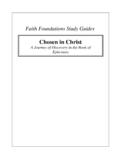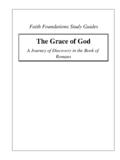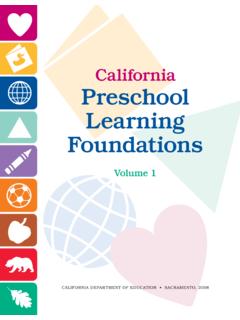Transcription of Faith Foundations Study Guides
1 Faith Foundations Study Guides God Revealed in the Son A Journey of Discovery in the Book of Hebrews Alan Perkins 2009 All rights reserved. Printed in Unless otherwise noted, Scripture quotations in this publication are from the HOLY BIBLE, NEW INTERNATIONAL VERSION . NIV Copyright 1973, 1978, 1984 by International Bible Society. Used by permission. All rights reserved. How to Use This BookWelcome to the Faith Foundations Study guide on Hebrews! Whether you are just beginning your new life with Christ, or have been a Christian for many years, this Study guide is for you. It is designed to help you discover, through personal Study and group discussion, the incredible riches of God s Word, and to help you grow in your walk with God by applying what you learn. This book is divided into 26 lessons, each of which contains the full NIV text of the Scripture passage, several Study and discussion questions, and a verse-by-verse commentary.
2 So, together with a Bible to look up cross-references, you have everything you need for your "journey of discovery" in Hebrews. Why Small Groups? These materials can be used profitably in personal Study or in an adult Sunday School class. But their value will be best realized when they are used in small groups, meeting either at church during the Sunday School hour or in homes during the week. There are several reasons for this. First, no one has perfect insight into every passage of Scripture; we can all benefit from hearing the perspectives of other believers as we seek to understand and apply the Bible. A small group gathering, using the discussion questions included in this book, is an ideal way to stimulate a sharing of observations and ideas. Second, a small group provides a community of fellow travelers who, along with us, are seeking to follow Christ in the midst of family responsibilities, job pressures, and personal struggles.
3 In today s fragmented and mobile society, the natural networks of neighborhoods and family no longer provide the support they once did. We need some way of making connections with others for mutual support, people with whom we can share our joys and sorrows people who will listen, who will pray with us, who will offer a helping hand and a word of encouragement, and who will confront us in love when we ve gotten off track. Finally, a small group combines the benefits of Biblical insight and community support by keeping us accountable. If we only Study the Scriptures alone, or listen to them taught in a large group, it s easy to let them go "in one ear and out the other". But when a small group of people are learning the same things at the same time, they can help one another to apply the things they are learning. How Are the Groups Organized? The groups should be composed of 6-14 people: if they are smaller, any absences can make it difficult to maintain the discussion; if they are larger, not everyone can participate.
4 You can meet from two to four times a month; if the group meets less than twice a month, the members aren t spending enough time together to build relationships. Some groups find that meeting three times a month during the school year, with a break during the summer, provides a good rhythm of involvement and time off. You may choose to include a mix of married and single, older and younger members, or you may organize your groups by age or marital status. There are benefits to homogeneous groups in which the members are going through similar life experiences, but there are also benefits of a diverse group in which the younger members can benefit from the experience of the older. Each group needs to have a recognized leader, preferably one selected and trained by the pastor or church leadership. This person s role during the meeting is not primarily to teach (although preparation of the lesson is a must), but to guide the discussion and keep the group from getting bogged down on side issues.
5 He or she does not need to be the host; in fact, it is preferable that group responsibilities, such as providing a home in which to meet and organizing refreshments, be shared among the members. Finally, membership in the group should be based on three commitments: To prepare for each meeting by completing the lesson in advance, which takes from 1/2 to 2 hours (but come to the meeting even if you haven t done the lesson); to place a high priority on regular attendance and come to the meetings except in case of emergency; and to keep confidential anything of a personal nature which is shared during the meetings (except when it is necessary to communicate concerns to the pastor). What Is the Group Meeting Like? Each group meeting should last from 1 1/2 to 2 hours, and provide time for discussion of the lesson, prayer, and fellowship. A problem in many groups is for the lesson to take up most of the time, with only a few minutes left over for prayer and fellowship.
6 This must be avoided for the goal of building relationships to be achieved. Here is a suggested schedule: 15 minutes: Gathering 30-45 minutes: Discussion of the lesson 20-30 minutes: Prayer 15-30 minutes: Refreshments As for child care, experience has shown that in order to receive the maximum benefit from time spent in the meeting, all members of the group need to be free to focus on the discussion, rather than caring for children. Therefore, with the possible exception of infants under one year, parents should make arrangements for child care during the meetings. Some options include "trading" child care with parents whose group meets on a different night, having a baby sitter care for children in another room during the meeting, or providing child care for all the groups at the church. Introduction to HebrewsAuthor The author of this letter is not identified. From the time of the early church fathers until the Reformation, Hebrews was generally considered to be the work of the apostle Paul, although with reservations.
7 Origen (c. 185-254), noting the differences between the elegant Greek of Hebrews and the less polished style of Paul's writings, wrote that "the thoughts are the apostle's, but .. the style and composition belong to one who called to mind the apostle's teachings and, as it were, made short notes of what his master said." Today, Pauline authorship of Hebrews is almost universally rejected. The style of Hebrews is that of a master rhetorician, while Paul acknowledges that he is not a "trained speaker" (2 Cor. 11:6). The vocabulary of Hebrews is distinctly non-Pauline: there are over 150 words in Hebrews which occur nowhere in Paul's writings. In addition, Heb. 2:3 states that the author received the gospel indirectly from "those who heard him [ Christ]", while Paul claims to have received it directly "through a revelation of Jesus Christ." (Gal. 1:12). From the letter itself, we know that the author was acquainted with Timothy (13:23), and thus presumably one of Paul's associates.
8 From his familiarity with the Jewish traditions and sacrificial system, we conclude that he was a Jew; his skillful use of language indicates that he was an educated Greek. Theories as to his identity vary. Martin Luther proposed Apollos, described in Acts 18:24 as a "learned man"; Barnabas, Peter, and several others have also been suggested. However, in the end we must concur with Origen, who concluded that "who wrote the epistle, in truth God knows." Date and Place of Origin We have clues to the date of Hebrews in the author's references to his readers' past sufferings, in which they were "publicly exposed to insult and persecution" (10:32-34), and in his remark that they had "not yet resisted to the point of shedding .. blood" (12:4). It is reasonable to suggest that the letter was written to those who had suffered under the expulsion of Jewish Christians from Rome by the emperor Claudius in 49, and who were fearful of the more severe persecution which the Christian community in Rome was experiencing at the end of Nero's reign, 64-68 As to the place from which the letter was written, we have no firm internal or external evidence.
9 Destination and Recipients Hebrews 13:24, which states that "those from Italy send you their greetings," could mean that the letter was written from Italy. More likely, it indicates that the author is in fellowship with Christians who had left Italy, perhaps as a result of persecution, and that he is relaying the greetings of these Italian expatriates to their countrymen. The most likely destination in Italy would be Rome, the location of the most important church in that area. Several factors indicate that the recipients of this letter were predominately, if not exclusively, of Jewish background. The author assumes that they share his familiarity with the Old Testament and with extra-biblical Jewish tradition. His insistence on the superiority of the new covenant over the old, and of the sacrifice and priesthood of Christ over those of the Jewish ritual system, makes more sense as being addressed to Jewish Christians tempted to revert to Judaism than Gentile Christians tempted to revert to paganism.
10 It is probable also that this letter was written, not to an entire church, but to a smaller fellowship, such as a house-church. They are characterized as having been Christians for some time (5:12), which argues against the likelihood that they were a large group composed of both newer and more experienced Christians. The author's request that they greet "all God's people" (13:24) also suggests a wider local community outside this group. Occasion and Purpose This letter is occasioned by a deep crisis of Faith in a fellowship of believers with whom the author is personally acquainted (13:19) and for whom he feels a pastoral concern and responsibility. Although in the past they had maintained their confession in the midst of suffering (10:32-34), they are now being tempted to retreat from their commitment to Christ; some of them have already done so (3:12, 10:25). Whether the cause of their spiritual malaise is the prospect of renewed suffering or just the strain of maintaining their Faith in a hostile environment (12:3-7, 13:13), they are in danger of drifting away.









